Here are few terminologies that should be used if you are in a field of UX.
You will find useful theories and principles that will help you in more meaningful communication.
Lean UX
A design that delivers the end goal and eliminates unnecessary tasks
KISS principle
This principle states that simplicity should be a core aspect of any design, with complexity kept to a minimum
3 Click Rule
This is the theory that users will leave a website if they can’t get to the page they want within 3 click
5 Second Test
A 5 second test involves showing users the interface of software application or a website for 5 seconds. The participant then has to recall what they saw on the page. This is a great method to see whether the key visuals or calls to actions have been a correct impact.
80/20 Rule
This is based on the Pareto principle. Applied to any website, web app, or software environment, 20% of the functionality and features will be responsible for 80% of the results.
A/B Testing
A/B testing is when you test two different versions of online content with users to see which one they prefer.
Accessibility
Accessibility is the ease with which people can use and understand a website or app. This also refers to how websites and apps are adapted for those with disabilities or special needs. An example of this could be adapting colours to allow for people who are colour blind.
Tunnelling
Guiding users through a sequence of activities, step by step, to encourage certain behaviours
Active Listening
This is an interviewing technique where the interviewer pays attention and provides feedback to encourage the conversation.
Analytics
Analytics gives valuable information on the traffic to your website and app. It tells you where your traffic comes from and where they move around. It gives a great insight as to what is working or not with your site /app.
Card Sorting
Card sorting is a method used to help design or evaluate the information architecture of a site. In a card sorting session, participants organise topics into categories that make sense to them. They may also be asked to label these groups. To do a card sort, you can use cards, pieces of paper, or an online card sorting tool.
Ethnography / Ethnographic Research
This is the study of people in their own environment through the use of methods such as observation and face-to-face interviewing.
Minesweeping
An action designed to identify where on a page links are located. Minesweeping involves the user rapidly moving the cursor over a page, watching to see where the cursor or pointer changes to indicate the presence of a link.
Omni-Channel UX
An experience including many touchpoints with consistency and seamless movement between them
Persona
The creation of a representative user based on the available data and user interviews. Though the personal details of the persona may be fiction, the information used to create the user type is not.
Survey
A survey is a list of questions aimed at extracting specific data from a particular group of people. Surveys may be conducted by phone, the internet, face-to-face and various other ways.
Usability
How effectively, efficiently and satisfactorily a user can interact with a user interface.
User Research
User research focuses on understanding user needs, behaviours and motivations through observation techniques, task analysis, and many other methods
Ideate/Brainstorm
A mode of the design process in which you concentrate on idea generation.
Adaptive Web Design (AWD)
A method in which a designer comes up with a design that fits all the screen resolutions
Aesthetic Usability Effect
A mindset that accepts a good looking design (WOW) as more usable than the one that is less appealing, whether or not that is actually the case.
Agile
An iterative, incremental and highly flexible approach to designing and developing digital products.
Iterative Design
In a bid to improve quality and functionality, this approach involves a cyclic process of prototyping, testing and refining a product
Eye Tracking
This is the measurement of eye activity on a screen or an environment. Eye tracking software allows the user’s eye movement to be tracked on a screen. It can see what they look at most frequently and in what order.
Mobile first design
The practice of designing for the smallest expected screen size, then enhancing on larger screen size.
Final Word
That’s a look at some of the more common UX/UI terms you’ll see in the design world. Bookmark this page and use it as a reference. By no means is this the be-all-end-all of web design terminology, so feel free to add your own, in the comments.


